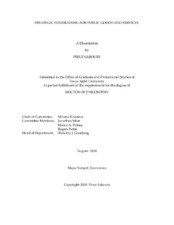| dc.description.abstract | In this dissertation, I study two pro-social markets and employ the theory of signaling games to understand how socially motivated institutions strategically choose fundraising mechanisms to convey private information to social investors in non-transparent environments. My findings explain two empirical observations about the charitable giving market and the microfinance market.
First, I focus on leadership giving in charitable fundraising. While existing theory predicts
that matching leadership gifts raise more voluntary contributions for public goods than seed money, recent experiments find otherwise. I reconcile the two by studying a model of leadership giving with incomplete information about the quality of public good. Both the fundraising scheme and the lead donor’s contribution size may signal quality to donors. I show that if the lead donor is informed about quality, she will convey information to downstream donors through the size of her contribution. Thus, the charity will have no signaling concerns and opts for a matching gift to mitigate free-riding. However, when the lead donor’s information is limited, her contribution is less informative, and a high-quality charity utilizes the fundraising scheme to convey information. In particular, a high-quality charity uses seed money as a costly signal to convince donors of high quality. Therefore, seed money becomes a stronger signal of quality and induces higher expected contributions.
I then turn to the microfinance market, where the commercialization trend in a once entirely non-profit industry, has triggered much debate. While some argue that the transition to a for-profit sector is a necessary step towards efficiency, others believe that profit-seeking results in mission drift, i.e., a diversion away from the original mission of helping the poor. I explain this polarization using a model where micro-lending costs are increasing in poverty, and there are two types of social investors: Rawlsians whose goal is to help the poorest of the poor and utilitarians who aim to maximize consumer surplus. With unobservable costs, commercialization signals low costs, which appeals to utilitarians but dissuades Rawlsians due to the wealthier borrowers associated with low costs. Therefore, with a predominately Rawlsian investor pool, all MFIs (microfinance institutions) operate as non-profits. However, when utilitarian preferences prevail, low-cost MFIs who serve the marginal poor, offer high repayment to investors to separate from high-cost MFIs. The latter, who operate in highly impoverished communities, remain non-profit. Hence, utilitarian investors divide the microfinance mission between for-profits who raise more funds and serve the marginal poor, and non-profits who carry on the more costly task of serving the poorest of the poor. | en |


